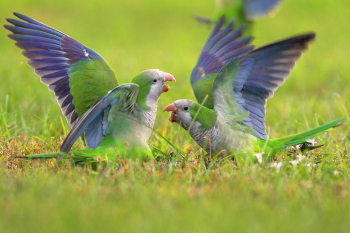
|
| Monk Parakeets Fighting. The ability to determine rank amongst monk parakeets appears to be an act of cognitive reasoning. Credit: Greg Matthews |
Mental Math Helps Monk Parakeets Find Their Place in Pecking Order
September 10, 2015
KNOXVILLE—A study of aggression in monk parakeets suggests that where they stand in the pecking order is a function of the bird's carefully calibrated perceptions of the rank of their fellow-feathered friends.
Newly formed groups of monk parakeets do not show evidence that they perceive rank, yet an awareness of it emerges quickly, after about a week of interactions, which is when individuals direct aggression more frequently against those nearby in rank rather than with lower-ranked birds.
But how do the birds infer rank - their own and the rank of those in the rest of the flock - and then act upon it?
"Parakeets appear to be able to connect the dots in their groups, remembering chains of aggression, so if A fights B, then watches how B fights C and how C fights D and how D fights E, then A will use this knowledge to adjust how it interacts with E based on all of the fights in between," said the study's lead author Elizabeth Hobson, a postdoctoral fellow at the National Institute for Mathematical and Biological Synthesis.
The study published today in the journal PLOS Computational Biology sheds new light on how socially complex animal societies evolve and how dominance hierarchies are established.
A socially and cognitively complex species, monk parakeets inhabit a social structure organized by dominance hierarchies, such that each animal is ranked as dominant over animals below it and submissive to those above it in the hierarchy. Aggressive encounters usually drive rankings, and a higher rank, of course, often means better foraging and greater chances of reproductive success.
Unlike other animals that might use visual cues, such as size, or perceptional clues, such as spatial location, to determine rank, the monk parakeet appears to rely on other clues - ones that are based on newly acquired social knowledge, the study found.
In the study, Hobson and co-author Simon DeDeo of Indiana University and the Santa Fe Institute analyzed detailed observations of aggression in two independent groups of captive monk parakeets. Each group was observed over the course of 24 days.
"We looked for cases where we could clearly determine a winner when aggression took place - often these were cases where a bird approached another and knocked it off its perch. It's pretty easy to determine the winner in these kinds of events," Hobson said.
A total of 1013 wins in one group and 1360 wins in the second group were analyzed.
Mathematically sophisticated computation with this rich dataset then revealed that as individuals begin to interact and watch the fights of others, they accumulate knowledge of who wins in fights against whom. Once this knowledge is present, the birds use it refine their own behavior, for example, by avoiding fights with birds higher-ranked than themselves, but also birds that were much lower-ranked. Instead, they focused their aggression by choosing individuals with whom they might be closely matched. In effect, the aggression becomes more strategically directed.
Thus, the ability to determine rank amongst these socially precocious birds appears to be an act of cognitive complexity, learned through the bird's careful observation of how the other birds interact.
"Our approach provides insight not only into how these parakeets are behaving in their groups, but also into the cognitive skills they would need to exhibit these kinds of strategic behaviors. This allows us to start to understand the interaction between social and cognitive complexity and to begin to compare what we see in the parakeet groups to other socially complex species like primates," Hobson added.
Citation: Hobson EA, DeDeo S. 2015. Social feedback and the emergence of rank in animal society. PLOS Computational Biology. [Online]
Media Coverage Highlights
ScienceLine:
Pecking order for birdbrains
Nature World News:
Social status and birds: Monk parakeets establish rank based on aggressive behaviors
BirdChannel:
How do parrots determine the pecking order? They pay attention
WUOT's The Method:
Monk parakeets fight to the top
#
The National Institute for Mathematical and Biological Synthesis is an NSF-supported center that brings together researchers from around the world to collaborate across disciplinary boundaries to investigate solutions to basic and applied problems in the life sciences.
CONTACT:
Elizabeth Hobson, NIMBioS, +1-865-974-4974, ehobson@nimbios.org
Catherine Crawley, NIMBioS, +1-865-974-9350, ccrawley@nimbios.org
NIMBioS
1122 Volunteer Blvd., Suite 106
University of Tennessee
Knoxville,
TN 37996-3410
PH: (865) 974-9334
FAX: (865) 974-9461
Contact NIMBioS


